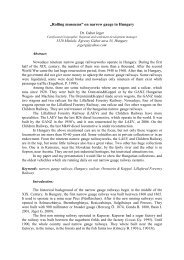'Representing Difficult Pasts within Complex Presents ... - T2M
'Representing Difficult Pasts within Complex Presents ... - T2M
'Representing Difficult Pasts within Complex Presents ... - T2M
Create successful ePaper yourself
Turn your PDF publications into a flip-book with our unique Google optimized e-Paper software.
12<br />
Figure 2 Seating sign inside James Hall Museum 'Cape<br />
Town' bus<br />
Immediately upon entering the bus, and<br />
only visible if one made the effort to peer inside,<br />
was a sign stating where ‘whites’ and ‘blacks’ could<br />
sit on the bus, immediately positioning the viewer<br />
<strong>within</strong> a different context of interpretation, moving<br />
from the bus as an inert, technological, and even<br />
aesthetic object, to a divisive cultural tool in the role<br />
of racial segregation, hierarchy and segregation as a<br />
passenger in South Africa’s past. The context shifts to the possibilities of representing disputes,<br />
controversies, boycotts, ways in which segregation was enforced, and resisted, in Cape Town city, and<br />
how it informed the ways in which people moved (or did not move) around 17 . Put the route back in and<br />
then one needs to ask which ‘group area’ or areas the bus served, and the disputes over who could travel<br />
where in relation to constructs of race and identity. Such interpretative frameworks present a material<br />
reality to understanding divisions of transports, networks and society in the past. However, other than the<br />
single sign inside the bus, there were no other alternative forms of interpretation for the silent and static<br />
buses that filled the hall – one had to have the presence of mind or curiosity to look inside the entrance of<br />
this particular bus amongst the many other buses, trolley buses and other such vehicles filling the hall. It<br />
would seem that the hall of buses, indeed, is ‘haunted’ by transport phantasmagorias of the past.<br />
To contrast the pristine representation of the green Cape Town bus, there was a sculpture of a<br />
burnt out shell of a bus (by Peter Meintjes) at the same time displayed at the Mayibuye Centre at UWC,<br />
which suggested a different take on the ‘bus’ as a transport theme; referring to riots and boycotts, the bus<br />
as a sign of defiance. Drawing on a different aesthetic framework, not one of mechanical manufacturing<br />
or engine technology, but of art, it is also aesthetically mesmerizing, and, in a sense, being created in the<br />
apartheid past of South Africa, arguably nostalgic. However, the sculpture of the bus clearly referents a<br />
more socially problematic view of transport history; one that led to social unrest rather than social order.<br />
If representations like this from artworks or photographs either in the Mayibuye Centre, which<br />
contains for example, large banners depicting buses, and photographs of segregation at bus-stops, could<br />
be displayed alongside buses in the James Hall Museum, a whole new and more pluralistic take on bus<br />
and transport history would become evident. Through contrasting two ethnographic ‘fragments’ from<br />
17 Pirie (see references) for example, has written extensively on the history of South African transport.




